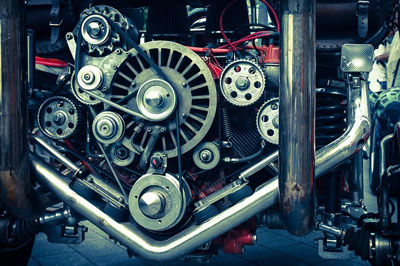
A car engine can appear intimidating to the untrained eye. Multiple moving pieces and parts all functioning in unison to supply the power for an automobile. Pistons, gears, cables, pulleys, a battery and belts all spinning and performing their specific functions to make the vehicle go. Belts are an integral part of the power supply and a general knowledge can assist with Denver car repair.
Most new model vehicles operate on a one-belt system while two-plus belt integration is slowly fading away. In certain circumstances, both a drive and timing belt are utilized to transition power from the engine to other parts of the vehicle.
Drive Belt
The drive belt is known by a variety of names and performs multiple functions inside a vehicle engine. Typically, most newer model cars and trucks operate with only one, extended belt wrapping around different pulleys, housed under the hood for easy power disbursement. Understanding the purpose of the belt and signs of wear will aid in determining when or if servicing is needed.
Another common name for the drive belt is fan belt as it operates some of the more essential pieces of an automobile. Often the air conditioning, power steering, water pump, alternator and other components are supplied power via this belt. If found inoperable, the vehicle will run until the battery fails due to no recharge supplied by the alternator. Also, driving becomes difficult with no available amenities like air or power steering.
Timing Belt
The timing belt or camshaft drive belt operates inside the engine moving components to ensure the engine runs properly. Depending on your vehicle make and model the timing belt may also supply power to some of the parts that typically use a drive belt. Despite this feature, the most noticeable difference between the two types of belts exists in the make-up. Drive belts are often smooth while timing belts normally have teeth located on the inside of the belt.
Both types have various lengths of service depending on a number of factors. Typically, a timing belt lasts between 60,000 and 100,000 miles. Whereas when looking to replace an accessory drive belt the time and distance vary considerably depending on the vehicle make and model. Drive belt service ranges from two years and 20,000 miles to 10 years or 150,000 miles.
Service
One of the more noticeable signs of service related to the belts will be first heard instead of seen. A belt will often begin to making an audible squeal from underneath the hood meaning the vehicle should be taken in for service immediately. Repair cost can be kept to a minimum if a belt is replaced prior to breaking. Also, noticeable wear and small tears can be visible signs of damage while missing teeth on a timing belt can also indicate service is needed.
The experts at Mancinelli’s Auto Repair Center can assist you in a full check of your engine’s belts or replacement, if necessary. All inspections and services will be completed by one of the many ASE certified technicians on hand to help you. Most services can be administered the same day so request an appointment online or call today.